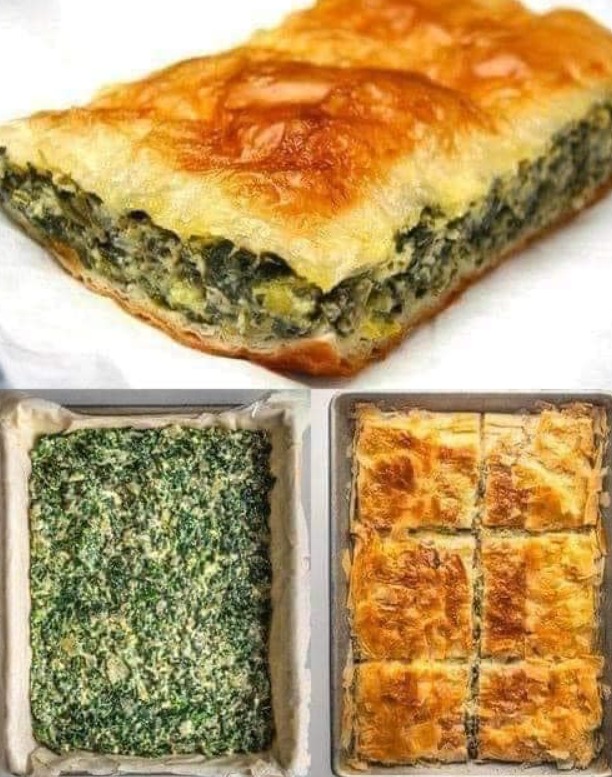
Spanakopita, a savory Greek pastry filled with spinach and feta cheese encased in layers of crispy phyllo dough, is a timeless classic celebrated for its irresistible taste and rich cultural heritage. This beloved dish, with its origins rooted in ancient Greece, has captivated generations with its delicate layers, vibrant flavors, and nourishing ingredients. Delving into its history unveils a tale of culinary tradition and innovation, while exploring its benefits reveals a treasure trove of nutrition and gastronomic delight. Here, we embark on a journey to uncover the irresistible charm, numerous benefits, and the art of preparing Spanakopita.
History:
The origins of Spanakopita can be traced back to ancient Greece, where the combination of spinach and cheese wrapped in pastry was a popular dish among the Greek aristocracy. The earliest known recipe for a spinach and cheese pie similar to Spanakopita appears in the 2nd-century Roman cookbook “Apicius.”
Over the centuries, Spanakopita evolved and adapted, influenced by various cultures and culinary traditions. The dish became especially popular in Greece during the Ottoman Empire, when phyllo dough—thin, unleavened pastry—was introduced to Greek cuisine. The combination of spinach, cheese, and phyllo dough became a hallmark of Greek cooking, cherished for its delicious taste and versatility.
Today, Spanakopita remains a beloved favorite in Greek cuisine, enjoyed as a meze (appetizer), side dish, or even a light meal. It is often served on special occasions, such as weddings, holidays, and family gatherings, symbolizing hospitality, generosity, and the joy of sharing food with loved ones.
Benefits:
- Nutrient-Rich Ingredients: Spanakopita is made with a combination of nutritious ingredients, including spinach, feta cheese, onions, and fresh herbs. Spinach is rich in vitamins A, C, and K, as well as iron, calcium, and antioxidants, while feta cheese provides protein, calcium, and probiotics.
- Heart-Healthy Fats: Phyllo dough, the pastry used to encase the spinach and cheese filling, is low in fat and cholesterol-free, making Spanakopita a heart-healthy option. The olive oil used to brush the layers of phyllo dough adds healthy monounsaturated fats, which are beneficial for heart health.
- High in Fiber: Spanakopita is a good source of dietary fiber, thanks to the spinach and whole wheat phyllo dough. Fiber is essential for digestive health, promoting regularity and supporting a healthy gut microbiome.
- Versatile and Adaptable: Spanakopita can be customized to suit individual taste preferences and dietary needs. The filling can be enhanced with additional ingredients such as dill, parsley, or pine nuts, while the phyllo dough can be layered with butter or olive oil for added richness.
Ingredients:
- 1 pound fresh spinach, washed and chopped
- 1 cup crumbled feta cheese
- 1 small onion, finely chopped
- 2 cloves garlic, minced
- 2 tablespoons olive oil
- 1/4 cup chopped fresh dill
- 1/4 cup chopped fresh parsley
- Salt and pepper, to taste
- 1/2 pound phyllo dough, thawed if frozen
- 1/2 cup melted butter or olive oil (for brushing)
Instructions:
- Prepare the Filling: In a large skillet, heat olive oil over medium heat. Add the chopped onion and garlic and sauté until softened, about 3-4 minutes. Add the chopped spinach to the skillet and cook until wilted, about 2-3 minutes. Remove from heat and let cool slightly.
- Mix the Ingredients: In a mixing bowl, combine the cooked spinach mixture with crumbled feta cheese, chopped dill, chopped parsley, salt, and pepper. Stir until well combined.
- Assemble the Spanakopita: Preheat the oven to 350°F (175°C). Place one sheet of phyllo dough on a clean work surface and brush lightly with melted butter or olive oil. Place another sheet of phyllo dough on top and brush with butter or olive oil. Repeat this process until you have a stack of 5-6 phyllo sheets.
- Add the Filling: Spoon a portion of the spinach and feta mixture along the long edge of the phyllo dough stack, leaving a border of about 1 inch. Roll the phyllo dough around the filling to form a log shape, then fold the ends under to seal.
- Bake the Spanakopita: Place the assembled spanakopita seam-side down on a baking sheet lined with parchment paper. Brush the top with additional melted butter or olive oil. Repeat the process with the remaining phyllo dough and filling.
- Bake the spanakopita in the preheated oven for 25-30 minutes, or until golden brown and crispy.
- Serve and Enjoy: Remove the spanakopita from the oven and let cool for a few minutes before slicing into individual portions. Serve warm or at room temperature as a delicious appetizer, side dish, or light meal.

Conclusion:
Spanakopita stands as a testament to the rich culinary heritage and vibrant flavors of Greek cuisine. Its origins rooted in ancient tradition, and its benefits extend far beyond its delicious taste. By mastering the art of preparing Spanakopita, you can savor the incomparable pleasure of this iconic Greek dish, celebrating the joy of good food, shared